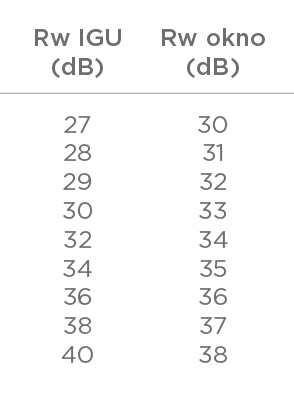One of the key characteristics of windows is their sound insulation (Rw), which is normally presented as:
Rw (C; Ctr) = 33 (-2; -6) dB
Rw represents weighted sound reduction index or a value that indicates how much dB is reduced when noise passes through the window. C and Ctr are correction factors, namely C for the medium frequency range (e.g. speech) and Ctr for the low frequency range (e.g. traffic). For example, the real value (Rw + Ctr) of the noise reduction of window by a traffic road is therefore 27 db (33-6 dB).
Assuming that the (closed) window is installed in walls properly and that sealing between the frame and the casement is properly ensured, Rw of insulated glass unit (IGU) has the greatest influence on the Rw of windows, which is the reason that the most attention is paid on Rw of IGU. Rw of windows is determined according to EN1451-1 up to Rw of IGU of 40 dB, whereas above this value, Rw of window is determined only experimentally in the laboratory.

The Rw of IGU is mostly within the range between 30 dB and 50 dB, and is mainly dependent on the thickness of the glass panes (e.g. 4, 6, 8 mm), the (a)symmetry of their IGU structure (e.g. 4/16Ar/4 or 6/16Ar/4) and the use of (acoustic) foils in laminated glass panes (e.g. 33.1, 44.2A). The distance between the glass panes (width of the spacer) and the type of inert gas has minor influence. Some examples are listed in the table below.

As a practical example, we can take traffic road in a city that causes noise with a level of 80 dB. Standard window with IGU structure of 4/12Ar/4/12Ar/4 (Rw of IGU = 31 db, Rw of window = 33 dB) reduces the noise to a level of 47 dB. Taking into account, that the noise level of the normal living in our homes is about 50 dB, such Rw is appropriate. If we consider also the correction factor Ctr, our ear will accept noise level of 53 dB. In this case, it makes sense to consider IGU like 6/12Ar/5/12Ar/4 with better Rw = 36 (-2; -6). With such IGU, our ear will accept noise level of 49 dB, as the Rw window, determined by standard, is 31 dB. The noise caused by the landing of the airplane (120 dB) or its take-off (140 dB) is so intense that it is reasonable to consider the highest Rw values (50 dB) taking into account also Ctr correction factor.
For better understanding of entire article a table with some examples of the noise level of everyday activities is listed below. The human ear barely perceives the sound difference of 1 dB, detects a difference of 3 dB, detects the difference of 6 dB well, and the difference of 10 dB very well.



